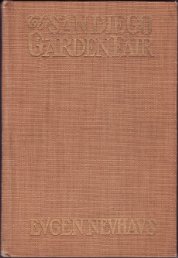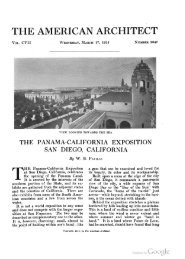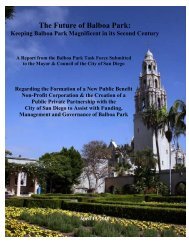Colonel David Charles Collier - Committee of One Hundred
Colonel David Charles Collier - Committee of One Hundred
Colonel David Charles Collier - Committee of One Hundred
You also want an ePaper? Increase the reach of your titles
YUMPU automatically turns print PDFs into web optimized ePapers that Google loves.
The most important civic posts <strong>Collier</strong> held in San Diego were those <strong>of</strong> Director-<br />
General <strong>of</strong> the Panama-California Exposition from 1909 to 1912, and President <strong>of</strong> the<br />
Exposition from 1912 to 1914. 45 He gave $500,000 <strong>of</strong> his own money to the Exposition,<br />
served without pay, and paid his own travel expenses on promotional trips to<br />
Washington, D.C., South America and Europe. 46 Consequently, his real estate business<br />
foundered, he was burdened by debts, and he was compelled to resign the presidency,<br />
March 5, 1914. 47<br />
<strong>Collier</strong> chose the central mesa <strong>of</strong> Balboa Park as the site for the Exposition, 48<br />
selected California Mission as the architectural style, 49 approved hiring Bertram Goodhue<br />
as consulting architect, 50 and decided on the Indian background <strong>of</strong> the Southwest as the<br />
Exposition's main cultural theme. 51 He was a founder <strong>of</strong> the San Diego Museum (today<br />
Museum <strong>of</strong> Man), a manager <strong>of</strong> the American School <strong>of</strong> Social Research in Santa Fe,<br />
New Mexico, and a friend <strong>of</strong> Dr. Edgar L. Hewett, director <strong>of</strong> the School <strong>of</strong> American<br />
Archaeology and first director <strong>of</strong> the San Diego Museum. 52<br />
<strong>Collier</strong>'s role in enlisting U.S. Congressional support <strong>of</strong> the San Diego Exposition<br />
did much to advertise San Diego, but he failed to get government recognition because <strong>of</strong><br />
opposition from San Francisco, which was organizing an exposition <strong>of</strong> its own. San<br />
Franciscans had acquired the support <strong>of</strong> conservatives in the Republican party. 53 When<br />
the conservatives succeeded in defeating the San Diego Exposition's bid for recognition,<br />
their triumph caused <strong>Collier</strong> to join the Progressive wing <strong>of</strong> the party. 54<br />
William Kettner, a San Diego Democrat, who was elected to Congress in<br />
November 1912, managed in his mild, un-<strong>Collier</strong>-like way, to secure the recognition<br />
<strong>Collier</strong> had sought. Since President Woodrow Wilson and Kettner belonged to the same<br />
party, the recognition went through speedily, without the intrigues that had beset<br />
<strong>Collier</strong>. 55<br />
To show they approved <strong>of</strong> <strong>Collier</strong>'s efforts for the Exposition, hundreds <strong>of</strong> San<br />
Diegans attended a reception in his honor, held at the Spreckels Theater, April 22, 1914.<br />
As Judge Ernest Riall presented him with a loving cup, his admirers shouted "What's the<br />
matter with <strong>Collier</strong>?", followed by the response, "He's all right!" 56<br />
<strong>Collier</strong> told his enthusiastic audience that he had accepted the presidency <strong>of</strong> the<br />
Pacific Southwest Railway. The railway would bring iron ore and coal from Colorado to<br />
San Diego, from which place ships would carry it around the world. He concluded:<br />
I feel I am again spending my energy for that town whose virtue, when it is once<br />
in a man's blood, makes <strong>of</strong> him a San Diegan in this life and in the life to come. 57<br />
Finding the Pacific Southwest Railway to be more talk than substance, <strong>Collier</strong><br />
bought back ownership <strong>of</strong> D. C. <strong>Collier</strong> and Co. in May 1914. 58 Still struggling with<br />
financial problems, he resumed his law practice in March 1915. 59 Panama-California







